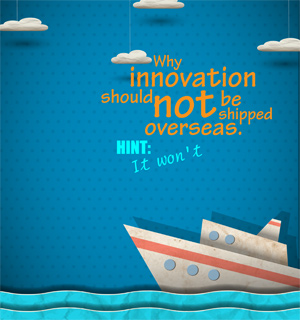
The ability for any region in the United States to be competitive may very well depend on how much it retains its innovation culture. Many call it nearsourcing, but no matter what vernacular is used, America can only succeed economically if municipalities from coast to coast help create local ecosystems to collectively conceive, design and manufacture the next great generation of products.
Often times, certain aspects of this product development value chain are shipped overseas in the belief that cheap, skilled labor is abundant and therefore better for an organization’s bottom line. It’s also seen as a way for startups to go to market without requiring as much capital investment. Sometimes this is true but usually the reality is different, especially for startups, entrepreneurs and smalland medium-sized enterprises (SME’s). These companies typically do not have the internal outsourcing experience, cultural knowledge or economies of scale to create a global product development team that delivers on cost and time to market. In this situation, it is better to keep these elements closer to home. Moreover, the organization’s innovation is more sustainable when using strategic partners that are close in proximity.
Nowhere is that trend more evident than when SME’s work with highly specialized manufactures and product development firms that are located near each other. This closeness breaks down all communication barriers and allows each of the teams to leverage its core competencies in business, design and fulfillment expertise to help deliver the finished product. This symbiotic relationship also spurs the development of the next great idea at a much faster pace than outsourcing overseas. Our manufacturing future is embedded in advanced manufacturing for the innovation economy.
Additionally, when time to market and production volumes are taken into consideration, a vibrant innovation community also spearheads a more cost effective manufacturing infrastructure that can meet the unique needs of startups and SMEs. It’s not uncommon that these types of companies require short production runs or have prototyping needs that larger overseas design and manufacturing firms can’t efficiently deliver. Manufacturers and product development firms who cater to this market will ensure this is done without breaking budgets by being involved early in the design cycle to improve product cost, quality, production agility and time to market. They will take advantage of existing supply bases, pre-fabricated parts with high yields and use of widely-used tests on the production line.
As much as a nearsource innovation community will help bring an SME’s idea to fruition, they can also help secure the necessary capital to give the concept the best chance of success. A regional ecosystem of entrepreneurs, product designers and manufactures can forge a solid product demo that is, in most instances, a critical component to get investors and market the concept to customers. Customers and financiers like to be wowed and a demonstrable proof of concept (POC) has a huge impact on their opinion of your abilities with their money. Along with the major feasibility proofing and the “dog-and-pony” opportunities, the POC provides additional validation to all aspects of the value proposition and cost structure. Marketing, sales, manufacturing, finance and research and development are able to validate and improve upon the plans and activities going forward based on the learnings achieved with the POC.
There’s another component to creating a robust nearsourced innovation community that, when present, is one of the best indicators of a thriving part of the regional economy. It’s the presence of non-profit organizations that look to create opportunities for area entrepreneurs, investors, manufacturers and service providers to get together and uncover ways in which business can get done. San Diego, for instance, is home to several of these forums, including CONNECT, which has a very robust intitiative that includes matchmaking and as educational seminars to promote nearsourcing. CONNECT is not the only organization that is contributing to this particular innovation community; BIOCOM, Software San Diego, CommNexus, San Diego Venture Group, the Association for Corporate Growth, to name a few, as well as several regional.
Economic development councils all help create the ecosystem to identify organizations that can add value in all aspects of the supply chain, from concept creation to distribution.
The bottom line is this. Outsourcing overseas provides very little added value for an SME or startup—let alone an entire region—in terms of maintaining a culture of innovation. What’s more, their perceived manufacturing and product development cost savings are often times illusions when an SME factors transportation costs and times, support and travel requirements, and quality management costs that typically are required to make such engagements successful. To maintain the innovative competitive edge that is essential to building a company’s value, organizations need to look toward their neighbors for assistance.

